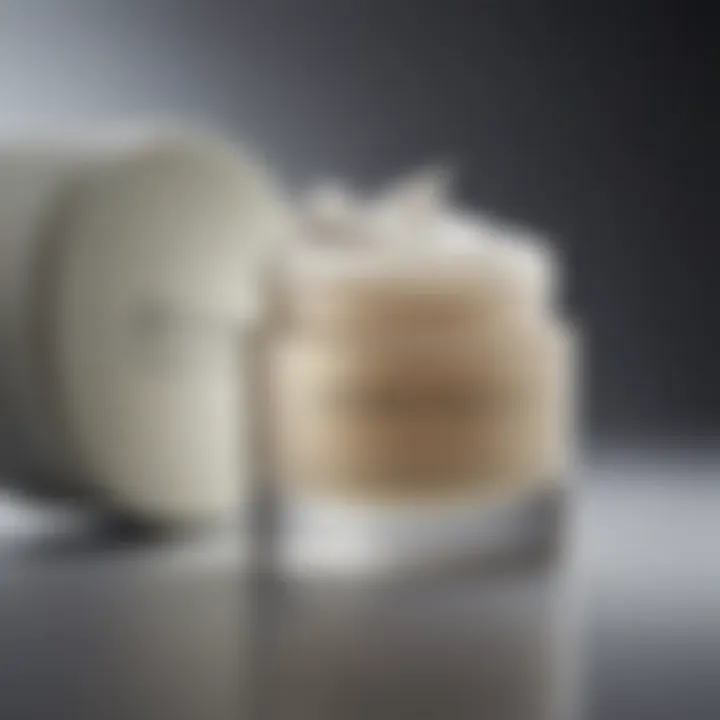The Importance of Very Light Moisturizers in Skincare


Intro
In the world of skincare, the choice of moisturizer plays a pivotal role, particularly for those seeking balance and hydration. Very light moisturizers have emerged as a preferred option for many individuals. They cater to various skin types and offer numerous benefits, making them a vital part of any skincare regimen. This article delves into the significance of these products, exploring their formulation, application techniques, and overall impact on skin health.
Tips and How-Tos
Understanding how to effectively incorporate very light moisturizers into skincare routines can enhance their benefits. Different skin types require tailored approaches to achieve optimal results:
Skincare Routines for Different Skin Types
- For Oily Skin: Choose gel-based moisturizers that absorb quickly. Look for ingredients like hyaluronic acid or glycerin that hydrate without adding excess oil.
- For Dry Skin: A light cream with moisturizing elements like squalane or aloe vera can provide nourishment without feeling heavy.
- For Combination Skin: A lightweight lotion that balances both oily and dry areas can be effective. Products with niacinamide may help regulate oil production.
- For Sensitive Skin: Consider fragrance-free formulas with calming ingredients such as chamomile or green tea.
Application Techniques
- Cleanse Thoroughly: Ensure that the skin is clean before applying any moisturizer to maximize absorption.
- Use Gently: Apply the product with light, upward strokes, allowing it to penetrate without force.
- Layering: For those using serums or oils, apply the very light moisturizer last to seal in benefits without clogging pores.
Formulation Components
The formulation of very light moisturizers often dictates their effectiveness. Key components include:
- Water-Based: Most contain a high percentage of water, making them lightweight and easily absorbed.
- Humectants: Ingredients like glycerin attract moisture to the skin, providing hydration without heaviness.
- Emollients: These soften and soothe the skin, enhancing texture while maintaining a light feel.
- Avoid Heavy Oils: Products should steer clear of oils like coconut oil that can weigh down the skin.
Each component plays a role in ensuring that the moisturizer hydrates efficiently without feeling greasy or thick.
"Light can be as powerful as heavy; it depends on the formula's ability to deliver benefits."
End
Very light moisturizers are essential for maintaining skin health across all ages and types. Understanding their significance and knowing how to select and apply them can lead to improved skin texture and appearance. In a time where skincare regimens are becoming more sophisticated, embracing the benefits of lightweight moisturizers is a step towards achieving a balanced and healthy complexion.
Understanding Very Light Moisturizers
Very light moisturizers play an essential role in contemporary skincare routines. They provide hydration without overwhelming the skin, particularly beneficial for those with specific skin types and unique needs. The relevance of understanding very light moisturizers extends beyond mere hydration. It involves learning which formulations work best for various conditions and how different ingredients contribute to skin health.
The significance of very light moisturizers can be recognized through their impact on skin balance. These products help maintain optimal moisture levels, which is critical for skin function. Leaving skin feeling refreshed rather than greasy, they promise effectiveness and comfort. They are ideal for warmer climates, where heavier creams can contribute to clogged pores and breakouts.
Moreover, light moisturizers often include ingredients that benefit skin without excessive weight. Thus, they are popular choices for a broad demographic, including teenagers and adults dealing with different skin concerns. Educating consumers on these products leads to better skincare choices.
Definition and Purpose
Very light moisturizers are skincare products designed to provide moisture without a heavy or greasy feel. They typically contain a higher concentration of water and offer a lightweight texture that absorbs quickly into the skin. These moisturizers aim to hydrate the skin while allowing it to breathe, making them suitable for a wide range of skin types, especially oily and combination skin.
The primary purpose of very light moisturizers is to maintain skin hydration. Well-hydrated skin appears plumper, healthier, and more radiant. Unlike heavy moisturizers, they do not create a barrier on the skin that can trap oil and lead to breakouts. This makes them a favorable option for individuals who require hydration but are prone to acne or excessive oiliness.
Historical Context of Moisturization
The practice of moisturizing skin dates back thousands of years. Ancient cultures utilized natural oils and fats to care for skin. For instance, Egyptians used olive oil while other civilizations employed animal fats to maintain moisture. Historical records show that the understanding of skin hydration primarily revolved around keeping the skin soft and flexible.
As time progressed, the development of synthetic materials expanded the landscape of skincare. In the 20th century, the introduction of emulsifiers led to the creation of various moisturizer types, allowing for a more nuanced approach to formulation. Today, very light moisturizers reflect an increased awareness of skin health and an emphasis on non-comedogenic ingredients. This evolution represents a shift towards lighter textures and formulations that align with modern skincare objectives.
In recent years, trends have shown a growing preference for products that are not only effective but also pleasant to use. This context adds importance to understanding very light moisturizers as viable and sensible choices in skincare.
Key Ingredients in Very Light Moisturizers
The effectiveness of very light moisturizers largely depends on the ingredients they contain. Each component plays a crucial role in delivering hydration and maintaining skin health. Understanding these key ingredients will shed light on their purpose and benefits. For anyone looking to improve their skincare routine, selecting a product with the right ingredients is essential.
Hydrators and Humectants
Hydrators, often termed humectants, attract moisture from the environment or deeper layers of the skin. Common humectants like glycerin and hyaluronic acid are renowned for their ability to hold water, making them vital for providing a plump and supple appearance to the skin.
- Glycerin: Non-greasy and effective, it draws moisture from the air and binds it to the skin.
- Hyaluronic Acid: This ingredient can hold up to 1,000 times its weight in water, making it incredibly powerful for hydration.
Humectant-based formulations are especially beneficial in dry conditions.
"Incorporating quality humectants into your routine can lead to visibly softer and more elastic skin."
Emollients and Occlusives
While hydrators draw moisture in, emollients and occlusives serve to seal it in. Emollients such as shea butter, coconut oil, and squalane provide smoothness and softness to the skin. They fill in the gaps between skin cells, leading to a smoother texture.
Occlusives, on the other hand, create a barrier that locks in hydration. Ingredients like petrolatum and beeswax form a protective layer on the skin. This combination of emollients and occlusives is especially useful for climates that lack humidity. Here is a simple distinction:
- Emollients: Improve texture and smoothness.
- Occlusives: Prevent water loss by creating a barrier.
Choosing a moisturizer with a thoughtful balance of these substances can significantly enhance overall skin hydration and comfort.
Active Botanical Extracts
Botanical extracts offer additional benefits, often bringing a range of vitamins, antioxidants, and anti-inflammatory properties. Ingredients like aloe vera, green tea extract, and chamomile are commonly included in very light moisturizers. These extracts can soothe irritated skin, combat free radicals, and promote skin healing.
Some notable benefits include:
- Aloe Vera: Known for its soothing properties and ability to hydrate without making the skin greasy.
- Green Tea Extract: Rich in antioxidants, it helps reduce redness and protect against environmental damage.
- Chamomile: Provides calming effects, making it ideal for sensitive skin types.


Incorporating these ingredients can enhance the overall efficacy of a moisturizer, ensuring that it does not just hydrate but also nourishes and repairs the skin.
Understanding these key ingredients helps in choosing the right very light moisturizer that suits individual skin needs. It emphasizes the importance of informed selections in skin health.
Skin Types and Very Light Moisturizers
Understanding how very light moisturizers interact with different skin types is crucial for effective skincare. Each skin type has its unique characteristics and needs. By tailoring moisturizer choices to specific skin types, individuals can achieve optimal hydration, improved texture, and minimized issues like breakouts or irritation.
Oily Skin
For those with oily skin, light moisturizers can provide hydration without adding excess oil. The key is to choose products that are non-comedogenic, which means they do not clog pores. Ingredients such as hyaluronic acid and glycerin help to retain moisture while keeping the skin's oiliness in check. A very light formula can help regulate sebum production, providing crucial moisture while minimizing shine. It is essential to apply the moisturizer as part of a consistent skincare routine, typically after cleansing and before sunscreen, to maintain a balanced complexion.
Combination Skin
Individuals with combination skin experience both oily and dry areas on the face. A suitable very light moisturizer should be lightweight yet effective. The goal here is to hydrate the drier areas of the skin without overwhelming the oilier zones. Products that contain balancing ingredients like aloe vera or chamomile can refresh the skin. Since combination skin can fluctuate with seasons or hormonal changes, selecting a moisturizer that adapts to varying conditions is important. Applying such products in layers, ensuring even distribution, can lead to a more balanced skin appearance.
Dry to Sensitive Skin
For dry or sensitive skin, even very light moisturizers need to be more nourishing. These formulas should contain soothing agents such as shea butter or ceramides to prevent irritation. It's a common misconception that light moisturizers are ineffective for dry skin. Instead, a specially formulated very light product can provide essential hydration without feeling heavy or greasy. For sensitive skin types, it is also advisable to look for products free of fragrances or harsh chemicals. A careful selection ensures that hydration is achieved without triggering reactions.
Benefits of Using Very Light Moisturizers
When discussing skincare, very light moisturizers are often overlooked in favor of more substantial options. However, their significance cannot be understated. Light moisturizers serve a critical role in maintaining skin health across various demographics. Understanding their benefits helps users make informed choices, ensuring that their skin gets the hydration it requires without being overwhelmed.
Using very light moisturizers can transform not just the way skin feels but also its appearance overall.
Enhanced Absorption
One notable advantage of very light moisturizers is their capacity for enhanced absorption. The formulas are usually designed with smaller molecular sizes that allow them to penetrate deeply into the skin's layers. This means that the ingredients, such as hyaluronic acid and other hydrators, can reach the dermis effectively.
- Hydration: Skin stays soft and hydrated longer.
- Fast-acting: Quick absorption helps reduce feelings of dryness almost instantly.
- Layering: Very light moisturizers can be easily layered under serums or heavier creams without leave a greasy residue.
Furthermore, the lightweight nature of these moisturizers means they do not clog pores. This factor is critical for maintaining a clear complexion.
Prevention of Breakouts
Another vital reason to choose a very light moisturizer is their role in preventing breakouts, especially for those with oily or acne-prone skin. Many people mistakenly believe that using any form of moisturizer exacerbates oily skin or induces acne. This notion is incorrect. In reality, the right light moisturizer can help balance oil production and reduce the likelihood of skin issues arising.
- Non-comedogenic: Most light moisturizers are formulated to avoid blocking pores.
- Oil control: They can actually help regulate the natural oil levels of the skin.
- Sebum regulation: Less oily skin means fewer chances for breakouts.
Thus, light moisturizers become essential in maintaining healthy skin while mitigating the risks of severe acne or clogged pores.
Improved Skin Texture
Lastly, very light moisturizers contribute to improved skin texture over time. Regular use can lead to a smoother, more refined skin surface. This improvement can be attributed to consistent hydration, which aids in skin barrier function and cellular turnover.
- Softer Skin: Users will notice a marked difference in softness when they incorporate light moisturizers into their routine.
- Even Tone: Frequent hydration can lead to a more uniform skin tone and texture.
- Minimized appearance of fine lines: Keeping the skin hydrated often results in plumper skin, helping to reduce the prominence of fine lines and wrinkles.
In summary, the benefits of using very light moisturizers extend beyond basic hydration. They offer enhanced absorption, prevention of breakouts, and improvement in skin texture, making them integral to a comprehensive skincare routine.
"Light moisturizers are important tools in achieving and maintaining healthy skin, particularly for those with specific skincare needs and challenges."
As the conversation around skincare continues, it is essential to recognize the full spectrum of options available, with very light moisturizers standing out as indispensable.
How to Choose the Right Very Light Moisturizer
Choosing the right very light moisturizer involves understanding several factors. These factors ensure that the selected product aligns well with your unique skin needs and lifestyle. The correct moisturizer will enhance your skincare routine, improving overall skin health and appearance.
Identifying Skin Needs
To select a suitable moisturizer, you should first identify your skin type. Skin types generally fall into four categories: oily, dry, combination, and sensitive. Knowledge of these types is crucial:
- Oily Skin: If your skin tends to shine throughout the day and you experience frequent breakouts, look for oil-free or gel-based moisturizers. These help hydrate the skin without adding extra weight, minimizing the risk of clogged pores.
- Dry Skin: If your skin feels tight and looks flaky, a lightweight but hydrating formula is essential. Look for products containing hyaluronic acid or glycerin, which can lock in moisture without feeling heavy.
- Combination Skin: This skin type requires balance. A moisturizer that provides hydration without excess oil can support both dry and oily areas. Lightweight emulsions work well here.
- Sensitive Skin: For sensitive skin, a very light moisturizer that is fragrance-free and contains calming ingredients, like aloe vera, may be the ideal choice. Keep an eye out for products marked as hypoallergenic.
Reading Ingredients Labels
Next, understanding the ingredients in moisturizers can greatly influence your choice. Ingredients are often the decisive factor in how effective and suitable a product is for your skin.
- Hydrators: Look for humectants like hyaluronic acid and glycerin. These ingredients draw water into the skin, making them ideal for very light moisturizers.
- Emollients: Ingredients such as squalane and plant oils provide softness. They are important as they fill spaces between skin cells, improving texture without heaviness.
- Avoid Irritants: If you have reactive skin, stay away from alcohols, synthetic fragrances, and parabens. Always double-check that your chosen moisturizer is free from potential irritants that can cause breakouts or skin reactions.
Considering Price and Brand Reputation
The price of skincare products can vary dramatically. While a higher price does not equate to better quality, it often reflects the ingredients used. Research plays a pivotal role here. Explore different brands:
- Brand Reputation: Choose products from brands known for their commitment to quality. Reputable brands typically invest in research and development, ensuring their products are effective and safe.
- Reviews and Testimonials: User feedback can guide you. Look for testimonials that highlight similar skin concerns as your own.
- Budget Considerations: Identify your budget beforehand but remain open to splurging on a product that genuinely meets your needs. Sometimes investing in a quality product can save you from future skin issues, making it a worthy investment.
"Understanding your individual skin needs and ingredient composition is critical in selecting an effective very light moisturizer."
By taking the time to evaluate these factors, you can significantly increase your chances of finding the right very light moisturizer tailored for your skin. This step is essential in establishing a beneficial skincare routine that genuinely supports your skin's health.
Application Techniques for Optimal Results
Understanding the proper application techniques for very light moisturizers is crucial in maximizing their benefits. These products, designed to hydrate without clogging pores, thrive when used correctly within a skincare routine. The following sections provide essential methods to enhance the efficacy of these moisturizers.
Layering Under Other Products


Layering very light moisturizers under other products is a strategic approach in skincare. When applied first, these moisturizers act as a base layer, allowing the skin to absorb hydrating ingredients effectively. This ensures that serums, oils, or heavier creams that follow can penetrate more efficiently. It’s important to allow each applied layer a moment to absorb fully before proceeding to the next. This technique not only prevents pilling but also optimizes hydration levels without overwhelming the skin. Incorporating a very light moisturizer can be especially beneficial in multi-step skincare routines, as it hydrates without adding excessive weight.
Timing in Skincare Routine
Timing plays a significant role in skincare. Applying very light moisturizers after cleansing and toning is ideal. This timing ensures the skin is prepped to absorb hydration. Choose to apply the moisturizer while the skin is slightly damp to lock in moisture, enhancing overall hydration. Be consistent and make this step a part of both morning and evening routines. Skincare routines should be customized based on personal skin needs, adjusting timings if necessary.
Massage Techniques
Utilizing proper massage techniques when applying very light moisturizers can yield substantial benefits. Gently massaging the product into the skin helps stimulate circulation and encourages lymphatic drainage, leading to a more vibrant appearance. Using upward and outward motions can enhance absorption and serve to lift the skin. Spend adequate time on areas that may need extra attention or hydration. Applying with these techniques also transforms a simple application into a pleasurable experience, making a mindful connection with one’s skincare routine.
“Effective application is the bridge between skincare theory and practice.”
Incorporating these application techniques ensures that very light moisturizers deliver their intended benefits and support a healthy skincare routine.
Myths Surrounding Moisturizers
Understanding the diverse misconceptions about moisturizers is essential to enrich skincare routines. Myths can hinder the correct choices individuals make when selecting facial products. Certain beliefs may discourage users from utilizing very light moisturizers. Thus, it is pivotal to debunk these misconceptions and empower the audience to embrace hydration effectively.
Moisturizers Aren't Necessary for Oily Skin
A common myth is that individuals with oily skin do not need moisturizers. It is often assumed that applying moisture can worsen oiliness or cause breakouts. In reality, oily skin can still be dehydrated. Environmental factors and hormonal changes can strip moisture away from the skin. A very light moisturizer keeps the skin balanced, preventing excess oil production. If the skin feels adequately hydrated, it may reduce the likelihood of overcompensation through oiliness.
Light Formulas Don’t Provide Adequate Hydration
Another widespread belief is that light formulations do not offer sufficient hydration. Some individuals feel only heavy creams provide the necessary moisture. However, modern formulations often combine effective humectants and emollients to ensure hydration without heaviness. Ingredients like glycerin and hyaluronic acid are common in very light moisturizers. These substances attract water to the skin and help maintain moisture levels, proving that lightweight options can also be highly effective in keeping the skin supple and well-hydrated.
All Moisturizers Are Created Equal
Finally, the idea that all moisturizers are the same fails to recognize the context and formulation distinctions. Very light moisturizers have specific roles tailored to balance and hydrate various skin types. Heavier creams may contain occlusive components that can trap moisture but might not cater effectively to oily or acne-prone skin types. It is essential to analyze labels, consider individual skin needs, and choose options based on personal experiences and requirements. Understanding that moisturizers serve different purposes will optimize skincare routines.
Comparing Very Light Moisturizers with Heavier Options
The distinction between very light moisturizers and heavier options is fundamental to understanding how each type serves various skin needs. Understanding this comparison assists consumers in making informed choices that cater to their individual skin profiles. In skincare, not all products are created equal. The choice between these two categories affects both immediate skin feel and long-term health.
Very light moisturizers are often characterized by their thin texture and fast absorption. They are primarily designed to hydrate without weighing down the skin. They work well under makeup or can act as the first layer of hydration in a multi-product routine. Heavier moisturizers, conversely, tend to contain more emollients and occlusives, creating a barrier to seal in moisture. Choosing the right type can mean the difference between comfortable, balanced skin and discomfort or breakouts.
Suitability for Climate and Environment
Climate plays a significant role in determining the suitability of very light moisturizers versus heavier ones. In humid conditions, the lightweight formulas often prove advantageous. They provide hydration without adding further grease or heaviness to the skin, which can exacerbate discomfort in muggy weather. On the other hand, heavier options may be preferable in arid environments where moisture levels in the air are low. These creams can establish a strong barrier against environmental stressors, helping to protect and nourish the skin effectively. People living in regions prone to drastic weather changes may find they need to switch between light and heavier moisturizers depending on their current climate.
User Preferences and Experiences
User preferences often dictate whether individuals lean towards light or heavy moisturizers. Many users prefer very light formulas for day-to-day use. They appreciate how these formulations disappearinto the skin without residue, offering immediate hydration without triggering any oily finish. Reviews frequently highlight user experiences where very light moisturizers have mitigated breakouts or provided a plump, dewy look.
In contrast, some users lean towards heavier options, particularly those with chronically dry skin or during specific seasons like winter. They find comfort in the thick texture and long-lasting moisture they provide.
In short, preferences come down to an individual's skin type, lifestyle, and even personal comfort levels.
Choosing the right moisturizer can be a vital step in achieving healthy skin. Always consider personal skin needs and preferences when making this choice.
Innovations in Moisturizing Technology
Innovations in moisturizing technology play a crucial role in the evolution of skincare. These advancements aim to enhance the efficacy of very light moisturizers, ultimately contributing to better skin health. Understanding these innovations helps consumers make informed choices about their skin care products. New formulations often incorporate cutting-edge science to maximize hydration while maintaining a lightweight texture. This balance offers a significant benefit to those who prefer or require less heavy products on their skin.
Smart Moisturizers
Smart moisturizers represent a unique category that uses advanced technology to adapt to individual skin needs. These products often contain sensors that detect moisture levels in the skin. Based on this feedback, the moisturizer can adjust its hydration delivery system. For example, if the skin is dry, the product may release more moisture. Conversely, if the skin is adequately hydrated, it will regulate the moisture output to prevent over-hydration.
The practicality of smart moisturizers lies in their ability to provide tailored hydration. They are especially beneficial for people with fluctuating skin conditions, such as those experiencing seasonal changes or variations in skin health due to stress or diet. Ausserdem, their adaptability often results in better absorption and effectiveness, leading to healthier skin without the weight of heavier formulations.
Biodegradable Formulations
Biodegradable formulations are another significant trend in the realm of very light moisturizers. These products are designed to minimize environmental impact by breaking down naturally after use. Traditional moisturizers may contain synthetic ingredients that can linger in ecosystems, raising concerns about pollution.
Biodegradable options often utilize natural substances that do not harm the environment. Ingredients derived from plants or sustainable sources are preferred, as they typically have a lower ecological footprint. Additionally, these formulations often meet the growing consumer demand for eco-friendly products, allowing users to feel good about their choices.
"The choice of biodegradable moisturizers reflects a shift towards responsible skincare that cares for both the individual and the planet."
In summary, advancements in moisturizing technology not only enhance hydration but also promote sustainability in beauty products. As consumers become more aware of the environmental impact of their choices, innovations like smart moisturizers and biodegradable formulations will likely lead the way in shaping future skincare trends.
Sustainability in Skincare Products
In recent years, sustainability has emerged as a crucial consideration in various industries, including skincare. The environmental impact of skincare products is gaining significant attention. Brands and consumers alike are beginning to prioritize eco-friendly practices. More people recognize that the choices made in skincare routines can affect both skin health and the planet. This section explores how very light moisturizers can contribute to a more sustainable skincare regime.
One major aspect of sustainability is the use of eco-friendly ingredients. This concept is becoming increasingly relevant in skincare as consumers demand products that are not only effective but also responsible. When discussing eco-friendly ingredients, it is essential to consider both their sources and their environmental impact. Ingredients derived from natural, renewable resources tend to be more sustainable than synthetic alternatives.
Eco-Friendly Ingredients
Eco-friendly ingredients play a significant role in the sustainability of very light moisturizers. Many brands now opt for plant-based ingredients. These are less harmful to ecosystems compared to petrochemicals. Natural botanicals, such as aloe vera and green tea, not only offer skin benefits but are also biodegradable.
Moreover, brands are becoming more transparent about their sourcing practices. This means stating the origin of their ingredients and opting for fair-trade options whenever possible. Using local ingredients can minimize the carbon footprint associated with transportation, contributing to sustainability. Additionally, organic certifications can assure consumers that the products meet specific environmental standards.
Incorporating these eco-friendly components into very light moisturizers can significantly reduce environmental harm. This approach not only benefits users but also promotes the health of the planet.
Sustainable Packaging Solutions


Packaging represents another essential element of sustainability in skincare. The skincare industry is known for excessive packaging, which often ends up in landfills. Therefore, sustainable packaging solutions must be a priority for brands. Very light moisturizers can be packaged in materials that are recyclable or made from recycled content.
Some companies are innovating with refillable designs. This allows consumers to reuse containers, drastically cutting down on waste. Other brands explore biodegradable packaging options that will break down over time. By focusing on sustainable packaging, companies reduce their overall environmental impact.
"Consumer consciousness regarding sustainability is reshaping the skincare market. Brands that prioritize eco-friendly practices will likely connect better with mindful consumers."
Implementing sustainable practices in both products and packaging is necessary for a responsible skincare routine. Ultimately, choosing very light moisturizers with eco-friendly ingredients and sustainable packaging not only enhances skincare but also supports a healthier planet.
Cultural Perspectives on Moisturizers
Understanding the cultural perspectives on moisturizers adds depth to the discussion of very light moisturizers in skincare. Different cultures have varying beliefs about skin health and beauty practices. These beliefs influence how consumers approach moisturization and the types of products they prefer. In many societies, moisture has always been synonymous with youth and vitality, making the exploration of these cultural nuances critical.
The significance of very light moisturizers is amplified when viewed through the lens of cultural trends and practices. People from diverse backgrounds prioritize specific climatic conditions, personal preferences, and biological needs that dictate their skincare choices. This cultural context contributes greatly to the acceptance and popularity of using very light moisturizers.
Global Trends in Moisturizers
In various parts of the world, the trend towards very light moisturizers correlates with an increasing awareness of skincare ingredients and their effects. The globalization of beauty standards plays a prominent role in altering attitudes toward hydration. In countries known for their commitment to natural products, such as South Korea, consumers frequently seek lightweight formulations that are easily absorbed by the skin. Furthermore, this trend is buoyed by a growing interest in minimalist routines aimed at achieving healthy and radiant skin without heavy layers of products.
"Minimalism in skincare is a global movement influencing product formulation and user habits. Such changes reflect not only consumer preferences but also evolving scientific research in dermatology."
This trend is noticeable in Western markets as well, where brands promote light moisturizers infused with botanical extracts that promise hydration without the burden of heaviness. Ingredients like hyaluronic acid or aloe vera are celebrated for their lightweight properties while maintaining efficacy. These changes highlight a shift in consumer mindset towards valuing quality over quantity in skincare.
Cultural Significance of Hydration
Hydration holds varied cultural significance across the globe. In some cultures, such as Japanese culture, the concept of skin hydration is synonymous with wellness and beauty. For this reason, very light moisturizers are not just a mere addition to a beauty routine; they represent a holistic approach to skincare.
In contrast, other cultures may regard heavy creams as a symbol of moisture retention, especially in arid climates. As a result, their skincare rituals may still lean towards thicker moisturizers, even if those are not necessarily effective for their skin type. Understanding these nuances reveals how hydration practices have evolved, influenced by both globalization and local customs.
This knowledge is essential for those looking to market very light moisturizers effectively. Brands that acknowledge and respect these cultural differences in hydration practices can tailor their messaging and product development to better resonate with their target audiences.
User Testimonials and Reviews
User testimonials and reviews play a crucial role in shaping perceptions around very light moisturizers. They provide firsthand accounts of experiences that can guide others in making informed choices. This section focuses on various elements, benefits, and considerations related to user feedback.
One significant aspect of user testimonials is their capacity to illuminate long-term effects. When individuals share their personal stories, they often highlight how a moisturizer has altered their skin over time. For instance, someone may describe how a product addressed their oily skin while maintaining hydration without causing breakouts. Such insights can influence potential users to consider very light moisturizers that might otherwise be overlooked.
Additionally, testimonials often reveal diverse perspectives across different skin types.
- Oily Skin: Users report a noticeable reduction in shine and breakouts.
- Combination Skin: Many find that these formulations balance hydration without overwhelming their skin.
- Sensitive Skin: Feedback frequently indicates fewer reactions compared to heavier creams.
"I have struggled with breakouts for years. After switching to a very light moisturizer, my skin feels hydrated and doesn’t break out as much," one user reports.
Another benefit of testimonials is that they foster a sense of community among users. The sharing of experiences can help individuals feel less isolated in their skincare journey. Online platforms like Reddit and Facebook often become forums for discussions pertaining to specific products. This social interaction can validate a user's choice or encourage experimentation with new formulations.
Considering user reviews also involves assessing the credibility of sources. While social media influencers often provide valuable insights, it is essential to cross-reference their claims with independent reviews to form a well-rounded viewpoint.
Overall, user testimonials serve not only as a guide for potential buyers but also as a resource for brands seeking to enhance their offerings based on consumer feedback.
Long-term Effects of Very Light Moisturizers
Long-term effects of very light moisturizers are of keen interest to many skincare enthusiasts. Many users notice improvements in skin health over an extended period when consistently using these products. This consistency often leads to better moisture retention and a more balanced complexion.
In addition to hydration, users frequently report enhanced skin elasticity and texture. These factors significantly contribute to the overall appearance of the skin, making it look smoother and more vibrant. For individuals with ongoing skin concerns, a gradual improvement can be quite compelling.
Some users may experience insights on how these moisturizers interact with other skincare products in their regimen. The cumulative effect of different products can influence how well a very light moisturizer performs. This information can create opportunities for potential users to explore combinations that work to their benefit.
Mixing Different Products
Mixing different products is an essential consideration for users of very light moisturizers. Many skincare aficionados often layer multiple products, each with unique benefits. While very light moisturizers can serve as excellent base layers, the choice of additional products can impact overall effectiveness.
Achieving an ideal balance between hydration and other skincare functions is critical. Users often seek to combine a very light moisturizer with serums or treatments specific to their skin concerns.
When mixing products, users should be mindful of ingredients. Some might find that certain combinations enhance benefits, while others may lead to irritation. It is often advisable to patch-test new product combinations before adding them into a daily routine.
Regular reviews highlight the importance of user experiences in discovering effective pairings. Feedback often includes suggestions, like selecting a hydrating serum that complements a light moisturizer, or avoiding dense creams that could disrupt the skin's oil balance.
Navigating the wide variety of available products can be overwhelming. Thus, user reviews often serve as valuable guidance in making practical choices, helping to avoid pitfalls while maximizing results.
Closure: The Evolving Role of Very Light Moisturizers
The importance of very light moisturizers in today’s skincare discussions cannot be overstated. This category of products has evolved significantly, adapting to the changing preferences and needs of consumers. Their lightweight properties make them ideal for various skin types, enhancing hydration without the heaviness often associated with traditional moisturizers.
As consumers are becoming more informed about skincare ingredients and formulations, very light moisturizers are placed at the forefront of many routines. They often consist of blendables with active components that address multiple skin concerns, which reflects the trend toward multifunctionality in skincare. Moreover, these moisturizers demonstrate adequate hydration capabilities, challenging the long-standing belief that only heavier creams can provide proper moisture.
The rise in interest towards these moisturizers can also be attributed to the increasing awareness of skin health overall. People now prioritize lightweight formulas that promote a natural glow without clogging pores or causing breakouts. The versatility of very light moisturizers allows individuals to easily incorporate them into their existing regimens, whether as standalone products or layered under serums and heavy creams, contingent on personal preferences.
Future Trends in Moisturization
The future of moisturization is likely to maintain the momentum that very light moisturizers have gained. Innovations in ingredient science and formulation technology are expected to lead to the development of even more effective and diverse products. For instance, the growing trend of personalized skincare may result in moisturizers specifically tailored to individual skin types and concerns. Ingredients such as hyaluronic acid, aloe vera, and green tea extract will remain prominent, but advances may lead to new hydrators with improved efficacy.
Tools such as skin analysis apps could also play a role in guiding consumers toward the right products. This technological integration enhances the user experience, allowing for tailored skincare regimens that optimize moisture levels effectively at every stage of life. Brands are likely to increase transparency in their formulation and testing processes, as consumers demand more information about their products.
Empowering Users in Skincare Choices
Empowering consumers in their skincare choices is crucial. With an ever-increasing array of products available, understanding the vast options can feel overwhelming. Education remains the foundation; consumers should understand the purpose of very light moisturizers and how to select the appropriate one for their skin needs.
In providing easy-to-understand resources and guides, brands can foster an informed consumer base. Materials that break down ingredient lists and explain their functions can demystify the selection process. Moreover, encouraging consumers to conduct patch tests and read reviews will enhance confidence in their choices.
Ensuring that users feel capable and knowledgeable about their skincare is a key factor in long-term satisfaction. Holistically, a consumer-centric approach will help shift perceptions around moisturization. The future of skincare lies in understanding, choice, and adaptability, particularly for very light moisturizers that respond to the needs of a diverse user base.
Consumer empowerment in skincare is about knowledge, choice, and confidence in selecting the right products that suit individual needs—leading to healthier skin and improved well-being.







